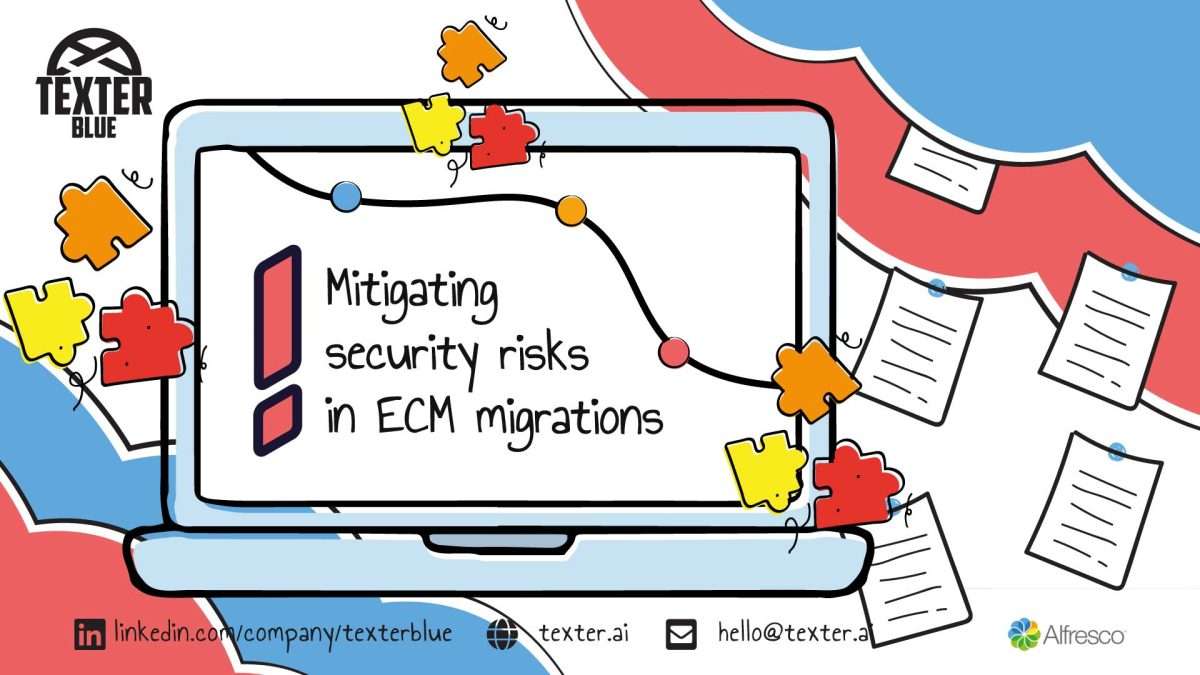Enterprise Content Management (ECM) migration is a critical task for organizations seeking to improve their content management capabilities. However, this process carries significant security risks that must be addressed to ensure the safety and integrity of sensitive data.
This article outlines the key security challenges in ECM migration and offers strategies to mitigate these risks effectively.

Introduction to ECM Migration
ECM migration involves transferring content, metadata, and workflows from one ECM system to another. This process is often driven by the need for enhanced features, better integration capabilities, or compliance with new regulations. Despite its benefits, migration poses several security risks, including data breaches, compliance failures, and internal misuse.
Identifying key security risks
External threats, such as hacking and malware attacks, are a primary concern during ECM migration. Hackers frequently exploit vulnerabilities in outdated systems or during data transfers. To mitigate these risks, organizations should implement advanced security measures, including encryption, firewalls, and intrusion detection systems.
Internal vulnerabilities, regularly from employees with access to sensitive data, are another significant risk. Poorly managed permissions and lack of proper training can lead to accidental or malicious data leaks. Role-based access controls and regular security audits are essential to minimize these risks.
Compliance and regulatory challenges during migration, maintaining compliance with industry-specific regulations (e.g., GDPR, HIPAA) is crucial. Non-compliance can result in hefty fines and legal repercussions. Organizations must ensure that the new ECM system adheres to all relevant regulations and that data is handled in a compliant manner throughout the migration process.
Software vulnerabilities, ECM systems typically integrate with other software platforms, creating potential vulnerabilities. Security flaws in one system can compromise the entire ECM infrastructure. Regular software updates, thorough code reviews, and security patches are necessary to prevent exploitation.
Disaster Recovery, whether natural or human-made, can disrupt ECM migration and result in data loss. A robust disaster recovery plan, including regular backups and off-site storage, is vital to ensure data integrity and continuity in the event of a disaster.
Strategies for mitigating security risks
Conducting a comprehensive security assessment before migration, organizations should perform a detailed security assessment of the existing ECM system and the new platform. This assessment should identify potential vulnerabilities and establish a clear plan for addressing them.
Implementing encryption and secure data transfer protocols, all data transferred during migration should be encrypted to prevent unauthorized access. Secure data transfer protocols, such as SFTP or VPN, should be used to protect data in transit.
Establishing role-based access controls, to prevent internal misuse, organizations should implement role-based access controls (RBAC). This ensures that employees have access only to the data necessary for their roles, reducing the risk of accidental or intentional data breaches.
Regular security training and awareness programs, employees play a crucial role in maintaining security during ECM migration. Regular training on security best practices and awareness programs can help employees recognize and avoid potential security threats.
Ensuring compliance with industry regulations, organizations should work closely with legal and compliance teams to ensure that all aspects of the migration process comply with relevant regulations. This includes data handling, storage, and transfer practices.
Testing and validation, before fully deploying the new ECM system, thorough testing and validation should be conducted. This includes penetration testing, vulnerability scans, and disaster recovery drills to ensure that the system can withstand potential security threats.
Smart content migration – Why Texport?
Ensuring data accuracy and completeness during migration is a multi-faceted process that requires careful planning, the right tools, and continuous monitoring.
Textport’s next iteration introduces Content Pipelines, a revolutionary feature that streamlines content management for enterprises. By leveraging targeted discovery queries during export, Content Pipelines seamlessly integrate enrichment workflows, empowering you to automate complex tasks and transform your content management process.
Check all the details here, and if you’re struggling with your digital transformation, remember… you are not alone in this… Texter Blue is here to help you to provide the best results! Make sure you read our news and articles and contact us.

